Abstract
The sustainable valorization of electrolytic manganese residue (EMR) and fly ash (FA) presents critical environmental challenges. This study systematically investigates the performance optimization of EMR-FA ceramic composites through the coordinated regulation of raw material ratios, sintering temperatures, and additive effects. While the composite with 85 g FA exhibits the highest mechanical strength, lowest porosity, and minimal water absorption, the formulation consisting of 45 wt% EMR, 40 wt% FA, and 15 wt% kaolin is identified as a balanced composition that achieves an effective compromise between mechanical performance and solid waste utilization efficiency. Sintering temperature studies revealed temperature-dependent property enhancement, with controlled sintering at 1150 °C preventing the over-firing phenomena observed at 1200 °C while promoting phase evolution. XRD-SEM analyses confirmed accelerated anorthite formation and the morphological transformations of FA spherical particles under thermal activation. Additive engineering demonstrated that 8 wt% CaO addition enhanced structural densification through hydrogrossular crystallization, whereas Na2SiO3 induced sodium-rich calcium silicate phases that suppressed anorthite development. Contrastingly, ZrO2 facilitated zircon nucleation, while TiO2 enabled progressive performance enhancement through amorphous phase modification. This work establishes fundamental phase–structure–property relationships and provides actionable engineering parameters for sustainable ceramic production from industrial solid wastes.
1. Introduction
Converting industrial solid waste into advanced functional materials has become a critical strategy in the circular economy and carbon neutrality efforts of the ceramic industry. This approach not only reduces environmental burdens but also creates value-added products from otherwise hazardous by-products [1,2,3]. The recent advances in solid waste utilization have demonstrated remarkable progress in converting various waste streams into high-performance ceramics, fundamentally shifting the paradigm from waste disposal to resource recovery. Contemporary research has expanded the understanding of waste-to-ceramic conversion mechanisms, with studies on municipal solid waste incineration fly ash geopolymers revealing how microstructural analysis can guide the optimization of waste-derived materials for specific engineering applications [4]. The synergistic utilization of multiple waste streams has gained significant traction, as evidenced by investigations on ternary blending systems that achieve enhanced material properties compared with single-waste systems [5].
Electrolytic manganese residue (EMR) is produced at over 10 million tons per year and contains manganese oxides, calcium sulfate, and various soluble salts. Its high heavy metal content and alkalinity typically classify it as hazardous waste [6,7]. These inherent physicochemical features make EMR and FA promising precursors for ceramic synthesis, since high-temperature sintering can encapsulate toxic elements while yielding mechanically robust structures [8,9,10]. Recent developments in fly ash-based hybrid systems under varying temperature conditions have provided valuable insights into how thermal processing parameters influence the structural integrity and performance of waste-derived materials [11], principles directly applicable to EMR-FA ceramic systems.
Transforming EMR and FA into dense, phase-stable ceramics remains technically challenging. The coexistence of diverse oxides and trace impurities leads to complex reactions during thermal treatment, disrupting the predictable phase transformation pathways and uniform microstructure formation. Recent work on ceramic foams has revealed how different factors influence crystalline phase reconstruction and microstructure regulation, providing frameworks for understanding how processing parameters can be tailored to achieve specific material properties [12]. A key factor is the thermal behavior of calcium sulfate dihydrate (CaSO4·2H2O), a major EMR component. It undergoes mul-tistage dehydration and decomposition between 100 °C and 850 °C, producing transient γ CaSO4 and CaO intermediates [1,13]. These intermediates then react with FA-derived aluminosilicates under non-equilibrium conditions, generating a dynamic reaction environment that limits reproducibility and property control [14,15].
Recent advances in additive engineering and sintering optimization have evolved substantially, with contemporary research emphasizing the strategic use of sintering aids to achieve desired properties at reduced processing temperatures. The effectiveness of controlled additive systems in achieving densification at lower temperatures while maintaining mechanical integrity has been demonstrated in various ceramic systems [16]. Advanced ceramic material optimization has benefited from the developments in processing techniques and performance prediction methodologies, including machine learning approaches for predicting high-temperature performance characteristics [17]. These computational approaches to ceramic optimization offer new possibilities for predicting and enhancing the performance of waste-derived ceramics.
Inorganic additives can modify reaction thermodynamics, stabilize intermediate phases, reduce defect densities, and facilitate sintering. CaO acts as a flux, lowers sintering thresholds, and promotes the crystallization of stable calcium aluminosilicate phases [18,19]. Na2SiO3 forms low-temperature melts that reduce the overall melting point by up to 200 °C and adjust siloxane network polymerization for improved densification [20,21]. ZrO2 provides thermal stability and enhances fracture toughness through its well-known phase transformation toughening effect [22,23]. TiO2 influences both amorphous and crystalline phases via its redox activity and internal lattice defect regulation, thereby refining microstructure and functional properties [24,25,26]. The integration of various additives has been shown to influence not only densification behavior but also phase evolution and microstructural development, with multi-component systems often demonstrating superior performance through synergistic effects.
The optimization of ceramic processing parameters has advanced through the improved understanding of surface engineering and performance characteristics. Recent innovations in ceramic processing have demonstrated how strategic parameter selection can significantly enhance ceramic performance [27,28,29]. The application scope of waste-derived ceramics continues to expand, with recent innovations in specialized applications demonstrating the versatility of these materials in demanding environments, including alkali-activated systems for marine applications [30] and high-temperature protective coatings [31].
Despite these advances, a systematic understanding of how these additives regulate micro-phase transformations during EMR-FA co-sintering is still lacking. This study investigates the physicochemical mechanisms of CaO, Na2SiO3, ZrO2, and TiO2 in EMR-FA ceramic systems, building upon the contemporary understanding of waste synergistic effects, advanced additive strategies, and optimized processing parameters. By integrating controlled sintering experiments with multi-scale characterization, we explore phase -evolution kinetics, identify dominant crystallization pathways, and assess the additive effects on porosity, densification, and heavy-metal immobilization. These insights aim to advance the scientific foundation for designing high-performance ceramics from industrial waste and to support scalable, cost-effective valorization strategies in sustainable material engineering, contributing to the expanding field of sustainable ceramic materials while addressing critical waste management challenges in the context of circular economy principles.
2. Material and Methods
2.1. Raw Materials and Additives
The electrolytic manganese residue (EMR) was sourced from Ningxia Energy Group Co., Ltd. (Yinchuan, Ningxia, China); the fly ash (FA) was obtained from Henan Refractory Materials Co., Ltd. (Zhengzhou, Henan, China); and the kaolin was procured from Shanxi Kaolin Co., Ltd. (Taiyuan, Shanxi, China). Additives including calcium oxide (CaO), sodium silicate (Na2SiO3), zirconium oxide (ZrO2), and titanium dioxide (TiO2) were all purchased from Shanghai Aladdin Biochemical Technology Co., Ltd. (Shanghai, China). Table 1 presents the chemical compositions of EMR, FA, and kaolin as determined by X-ray fluorescence spectroscopy (XRF). SiO2 and Al2O3 serve as the primary chemical components in all three materials. Minor quantities of CaO and traces of SO3 were detected in EMR. Additional constituents such as Fe2O3 and K2O were identified in both FA and kaolin, with Fe2O3 demonstrating the most substantial proportion (5.53%) among the secondary components. The remaining constituents exhibited approximate concentrations of 1%, thus their impacts on product performance are considered negligible.

Table 1.
Composition and content of electrolytic manganese slag, fly ash, and kaolin.
The mineralogical compositions of EMR, FA, and kaolin were investigated through X-ray diffraction (XRD) analysis. As revealed in Figure 1a, the predominant crystalline phases in EMR consisted of bixbyite ((Mn, Fe)2O3, PDF# 39-0476), gypsum (CaSO4·2H2O, PDF# 33-0311) and quartz (SiO2, PDF# 85-0865). FA is primarily composed of mullite (3Al2O3·2SiO2, PDF# 79-1455), whereas kaolin shares similar major phases, dominated by quartz (SiO2, PDF# 85-0865) and mullite (PDF# 79-1455).
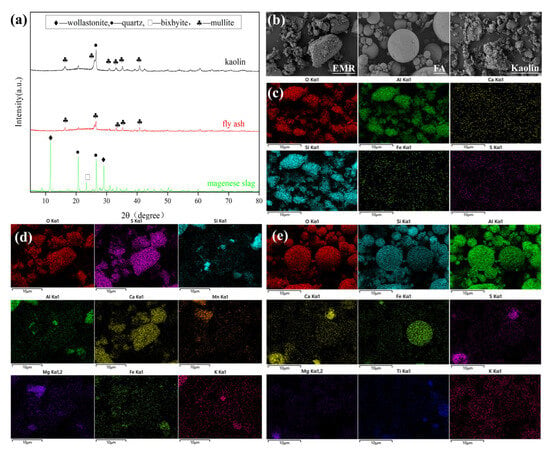
Figure 1.
(a) XRD patterns of EMR, FA, and kaolin; (b) SEM images depicting the morphology of EMR, FA, and kaolin; elemental mapping images of (c) kaolin, (d) EMR, and (e) FA.
SEM-EDS analysis was performed to characterize the microstructures and elemental distributions of EMR, FA, and kaolin. Kaolin presents a layered silicate structure, with O-Si-Al coordination consistent with its dioctahedral framework. Trace amounts of Ca, Fe, and S impurities are homogeneously dispersed throughout the mineral matrix (Figure 1b,c). EMR particles predominantly display blocky and columnar crystalline aggregates with adhered flaky secondary phases. The spatial overlap of O, Ca, and S signals confirms the presence of gypsum, whereas localized enrichments of Si, Al, Mn, and Mg correlate with quartz and manganese oxide phases (Figure 1b,d). The FA particles exhibit smooth spherical morphologies formed through coal combustion-induced vitrification. The homogeneous distribution of O, Si, and Al aligns with the crystallization of mullite and quartz, while localized Fe enrichment in certain spheres suggests iron oxide nucleation during FA solidification (Figure 1b,e).
2.2. Material Preparation Methods
The experiment was carried out in three stages. In the first stage, electrolytic manganese residue (EMR), fly ash (FA), and kaolin were accurately weighed according to predetermined ratios. The kaolin content was fixed at 15 wt% to balance moldability and sintering stability. This fixed kaolin proportion was determined based on preliminary experiments, which showed that contents below 10 wt% resulted in insufficient green strength, while contents above 20 wt% caused thermal shrinkage mismatch and surface cracking during sintering [32]. The raw materials were then ball-milled for 2 h, dried at 80 °C, and sieved through a 100-mesh screen. This step aimed to balance the formation of Mn-rich crystalline phases and the amorphous matrix and to identify the optimal raw material ratio.
In the second stage, functional additives (CaO, Na2SiO3, ZrO2, and TiO2) were added to the mixed powder, followed by the addition of 20 wt% water to improve plasticity. The mixture was uniaxially pressed at 20 MPa into square green bodies measuring 3 cm × 3 cm × 6 cm. This stage aimed to improve phase stability, densification, and interfacial bonding, and to investigate the effects of additives on microstructure, porosity, and mechanical properties.
In the third stage, the green bodies were dried at 60 °C for 24 h in a forced-air oven to stabilize their dimensions. Based on thermogravimetric–differential scanning calorimetry (TG–DSC) analysis and preliminary sintering trials, five sintering temperatures between 950 °C and 1200 °C were selected. The samples were sintered in air for 2 h to capture key phase transitions and densification behavior, thus optimizing the thermal treatment process.
2.3. Characterization of Material Methods
The phase composition of the target materials was analyzed using an X-ray diffractometer (XRD, X’Pert PRO, PANalytical, Almelo, The Netherlands) equipped with Cu-Kα radiation, operating at 40 kV and 40 mA. The scans were performed over a 2θ range of 10–80° at a rate of 2°/min with a step size of 0.02°. The chemical compositions of the raw materials were quantified using an X-ray fluorescence spectrometer (XRF, Axios, PANalytical, Almelo, The Netherlands).
Leaching behavior was evaluated according to the Chinese standard HJ/T 299-20071 (equivalent to the synthetic precipitation leaching procedure, SPLP) [33], and the leachates were analyzed for heavy metal concentrations using inductively coupled plasma mass spectrometry (ICP-MS, NexION 8300, PerkinElmer, Waltham, MA, USA). Microstructural and elemental analyses were conducted using a scanning electron microscope (SEM, Regulus8100, Hitachi High-Technologies, Tokyo, Japan) equipped with energy-dispersive spectroscopy (EDS), operated under high-vacuum conditions at an accelerating voltage of 15 kV.
3. Results and Discussion
3.1. Effect of EMR/FA Ratios on the Properties of Ceramic Materials
Figure 2a illustrates the significant influence of fly ash (FA) content on the physical properties of ceramic materials, including bulk density, porosity, and water absorption. In general, increasing the FA content enhances material densification, as reflected by a rise in bulk density and reductions in both porosity and water absorption. Specifically, when the FA content reaches 85 g, the porosity decreases to 27.64% and water absorption falls to 17.83%, indicating substantial microstructural densification. Figure 2b further demonstrates the relationship between flexural strength and the EMR–FA mass ratio. As the EMR content increases, the flexural strength decreases. In contrast, a higher FA content leads to improved strength, reaching a peak of 11 MPa at 85 g of FA.

Figure 2.
(a) Bulk density, porosity, and water absorption of materials with varying FA content; (b) flexural strength, and (c) XRD patterns of ceramic samples prepared with 40 g and 50 g of FA.
However, an analysis of intermediate compositions reveals additional insights. When the FA content is 40 g (45 wt% EMR/40 wt% FA/15 wt% Kaolin), the flexural strength reaches 8 MPa, and both the porosity and water absorption remain relatively low, indicating a balanced performance. Interestingly, increasing the FA content to 50 g results in a sharp increase in porosity (39.35%) and water absorption (29.95%), which may be attributed to an uneven particle distribution or insufficient bonding strength at high FA levels, ultimately leading to a more porous structure.
It should be noted that the current experimental design employed a preliminary screening strategy with FA content increments of 10 g (i.e., 40 g, 50 g, 60 g, etc.) to identify the composition range with a relatively optimal performance (Table 2).

Table 2.
Design of mass ratios for EMR and FA.
Although the monolithic ceramic sample containing 85 g of FA exhibited a superior mechanical performance, with a flexural strength of up to 11 MPa, the composite system consisting of 40 g FA and 45 g EMR demonstrated more practical and balanced engineering advantages when evaluated under multi-objective criteria, including environmental sustainability, resource utilization efficiency, and application feasibility.
Firstly, this formulation significantly enhanced the resource utilization efficiency of EMR, achieving a loading content of 40 wt% relative to the total solid mass—substantially higher than the 10–20 wt% typically reported in previous studies. EMR is a by-product of hydrometallurgical manganese extraction, characterized by strong acidity and the presence of environmentally hazardous ions such as Mn2+, SO42−, and NH4+. With an annual production amout exceeding 3 million tons in China, and limited access to economically viable treatment technologies, EMR is predominantly managed through long-term stockpiling, leading to serious land occupation issues and potential risks of soil and groundwater contamination. Incorporating a high proportion of EMR into ceramic materials not only promotes its solid-phase stabilization but also provides a technically feasible and scalable route for hazardous waste reduction and resource recovery, in line with the development of green building materials and circular economy strategies.
Secondly, although the physical performance of the 40 g FA + 45 g EMR composite is slightly inferior to that of the 85 g FA specimen, it still falls within the acceptable range for non-load-bearing construction applications. Specifically, the sample exhibited a flexural strength of 8 MPa, porosity of 33.9%, and water absorption of 24.1%. According to the Chinese industrial standard JC/T 626–2006 [34], the minimum compressive strength required for common sintered bricks is 7.5 MPa, with a water absorption limit of 25%. These values indicate that the EMR-containing composite satisfies the basic technical criteria for non-structural applications such as partition walls and sub-base materials, thus demonstrating its practical applicability.
Moreover, the composite exhibited excellent structural integrity and processing compatibility during sintering. The experimental observations revealed that the 40 g FA + 45 g EMR system developed a uniform pore structure with a low incidence of cracks and negligible linear shrinkage, indicating favorable dimensional stability and good sintering controllability. These characteristics are advantageous for scalable production and stable manufacturing, further supporting its potential for industrial implementation.
Two synergistic mechanisms account for the observed structural and performance improvements. Firstly, the incorporation of fly ash (FA) increases the content of Al2O3 and SiO2 in the system, which facilitates the formation of a more robust aluminosilicate network. This promotes stronger bonding within the Al–O–Si framework and stabilizes the SiO4 tetrahedra, thereby enhancing the structural compactness of the material. To verify this mechanism, X-ray diffraction (XRD) analyses were conducted with the FA additions of 40 g and 50 g (Figure 2c). The emergence of new crystalline phases such as cristobalite and margarite directly supports the hypothesis of Si–Al network reinforcement driven by the synergistic interaction between FA and kaolinite. Specifically, cristobalite—a high-temperature polymorph of SiO2—only forms when SiO4 tetrahedra are highly polymerized, while the formation of margarite depends on the presence of abundant and stable Al–O–Si linkages [35,36,37]. These results collectively indicate an enhanced degree of silicate network polymerization and the effective integration of aluminum—oxygen structures within the reaction system. In addition, the appearance of anhydrite (CaSO4) and aluminum oxide (Al2O3) further reflects intensified interactions between the Al–O and Si–O networks, facilitating the development of a more stable aluminosilicate framework [38,39].
Secondly, the relatively high bulk density of FA (2.3–2.6 g/cm3) improves particle packing efficiency. An increased FA content also elevates the viscosity of the melt during thermal treatment, which suppresses pore formation by restricting gas escape. These coupled chemical and physical effects significantly reduce porosity and water absorption while increasing bulk density and mechanical strength.
3.2. Effect of Sintering Temperature on the Properties of Ceramic Materials
Based on the experimental results presented in Section 3.1, the optimal composition was identified as the formulation containing 45 wt% EMR, 40 wt% FA, and 15 wt% kaolin. Therefore, the sintering temperature experiments in this section were conducted using this fixed composition.
Sintering temperature plays a critical role in controlling microstructural evolution in ceramic materials through thermally driven diffusion and phase transitions. Physical and mechanical data reveal distinct temperature-dependent behaviors. In the low-temperature inhibition stage (950–1100 °C), limited surface diffusion and initial pore merging reduce bulk density from 1.45 g/cm3 to 1.33 g/cm3 (Figure 3a). During the intermediate reorganization stage (1100–1150 °C), viscous flow sintering maintains a bulk density at 1.33 g/cm3. In the high-temperature activation stage (above 1150 °C), enhanced volume diffusion and pore refinement promote densification, increasing bulk density to 1.79 g/cm3 and reducing porosity from 37.2% to 15.61%. Flexural strength rises sharply, reaching 14 MPa at 1200 °C, indicating improved mechanical integrity under optimal sintering conditions (Figure 3b). Figure 3c demonstrates how sintering temperature affects the mineralogical composition. As temperature increases, the peak intensity of the quartz phase decreases, indicating progressive melting and the reorganization of its crystal structure. Prior studies have shown that the phase transitions in ceramics are strongly influenced by both the composition and thermodynamic factors [40,41]. Wang et al. reported that Al2O3 addition affects phase transition kinetics by reducing the formation of liquid phases, thereby stabilizing quartz and slightly enhancing mechanical performance [42]. Meanwhile, the peak intensity of the anhydrite phase declines significantly, while the anorthite phase becomes dominant. This suggests a high-temperature transformation from quartz and anhydrite to anorthite, described by the following reaction (Equation (1)):
SiO2 + CaO + Al2O3 → CaAl2Si2O8 (anorthite)
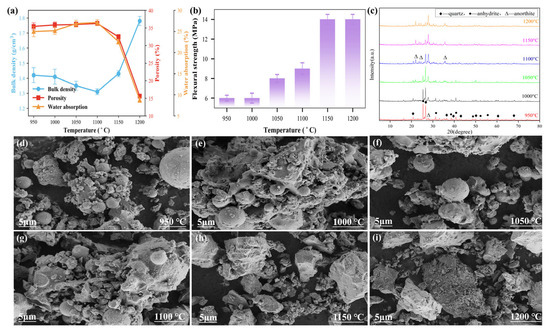
Figure 3.
(a) Bulk density, porosity, water absorption, and (b) flexural strength of materials under different sintering temperatures; (c) XRD patterns of materials at varying sintering temperatures; SEM images of materials sintered at (d) 950 °C, (e) 1000 °C, (f) 1050 °C, (g) 1100 °C, (h) 1150 °C, (i) 1200 °C.
Anorthite, with a high melting point (1530 °C), improves both the structural stability and flexural strength during high-temperature sintering [43,44]. Microstructure also evolves with temperature. Spherical particles dominate in the 950–1100 °C range, while irregular grains become prominent above 1150 °C (Figure 3d–i). At 1150 °C, abrupt morphological changes—such as particle fracture and collapse—indicate the onset of FA-related expansion reactions. These observations confirm 1150 °C as a key threshold temperature for initiating viscous flow sintering and gas-induced transformations within the aluminosilicate matrix.
To better understand the physicochemical transformations of the ceramic material with an optimal composition of 45 wt% EMR, 40 wt% FA, and 15 wt% kaolin during sintering, thermogravimetric and differential scanning calorimetry (TG-DSC) was performed to characterize the material’s mass changes and thermal responses under heating conditions. As shown in Figure 4, two major weight loss stages were observed during heating, both accompanied by distinct endothermic effects, indicating the typical processes of moisture release, decomposition, and solid-state reactions in the system.
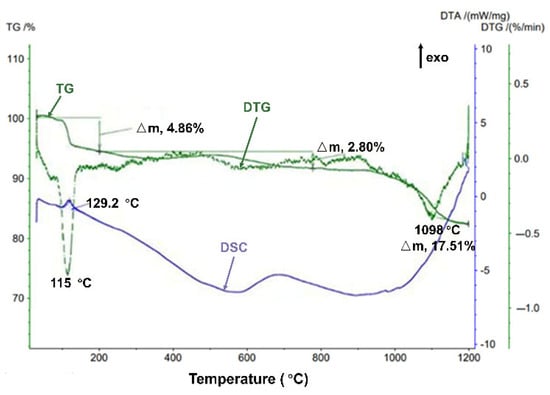
Figure 4.
TG−DSC curves of the ceramic sample with the optimal composition of 45 wt% EMR, 40 wt% FA, and 15 wt% kaolin.
At around 115 °C, the TG curve shows a weight loss of approximately 4.86%, corresponding to a clear endothermic peak in the DSC curve. This mass loss is mainly attributed to: (1) the evaporation of free and physically adsorbed water in the raw materials; (2) the stepwise dehydration of CaSO4·2H2O in the EMR, forming CaSO4 through intermediate phases; (3) the release of chemically bound water from fly ash [45]. The water removal at this stage helps eliminate physical barriers within the green body, promotes uniform shrinkage during initial heating, and provides favorable conditions for subsequent high-temperature reactions.
Near 1098 °C, the TG curve exhibits a second significant weight loss of about 17.51%, along with a strong endothermic peak. This stage involves more complex reactions, including: (1) the thermal decomposition of residual carbonates and unstable sulfates, releasing CO2 and SOx gases [46,47]; (2) the oxidation or pyrolysis of unburned carbon from fly ash, contributing further to mass loss; (3) more importantly, solid-state reactions among CaSO4, quartz (mainly from FA), and Si–Al phases formed from kaolinite decomposition. These reactions likely lead to the formation of thermodynamically stable high-temperature phases such as anorthite (CaAl2Si2O8), involving CaO (from gypsum or FA), Al2O3 (from kaolinite and FA), and SiO2.
Above 1150 °C, the TG curve levels off, indicating the completion of major decomposition reactions. The material enters the final sintering stage, characterized by grain growth, densification, and crystal phase reconstruction. Minor glass-phase formation and interfacial adjustments may also occur, which play a critical role in determining the final microstructure and mechanical properties.
The TG-DSC analysis clarifies the key thermal events and transformation mechanisms of the ceramic system during sintering. It not only provides a solid basis for understanding the intrinsic phase evolution behavior in the absence of additives but also offers valuable reference points for interpreting the effects of additives on the sintering behavior, phase development, and final properties.
3.3. Effects of Different Additives on Ceramic Material Properties
3.3.1. CaO
Calcium oxide (CaO) exhibits high thermal stability (melting point 2572 °C) and an elevated thermal expansion coefficient [48]. These properties enable effective interfacial stress accommodation during sintering while its chemical reactivity drives the following critical phase transformations:
SO3 + CaO → CaSO4 (ΔrGmθ = −298 kJ/mol, 1200 °C)
CaO + SiO2/Al2O3 → CaSi2Al2O5 (amorphous phase)
As the CaO content increased from 2 wt% to 10 wt%, the material exhibited a consistent enhancement in densification. Bulk density rose from 1.59 g/cm3 to 2.14 g/cm3, while porosity decreased from 25.86% to 8.24% (Figure 5a). This trend was mainly attributed to liquid phase sintering promoted by the formation of a CaO–SiO2 eutectic at elevated temperatures [49], which facilitated particle rearrangement and pore elimination. The SEM analysis (Figure 5d–h) further confirmed these observations, showing a progressive reduction in surface micropore number and pore size up to 8 wt% CaO, resulting in a denser and more uniform microstructure.
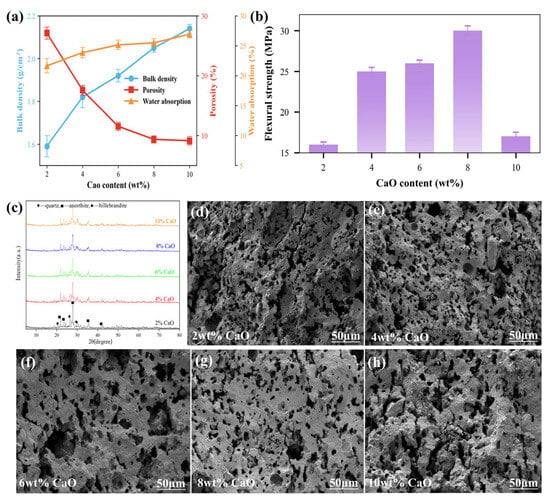
Figure 5.
(a) Bulk density, porosity, and water absorption of ceramic samples with different CaO contents; (b) flexural strength of the materials as a function of CaO content; (c) XRD patterns of samples with varying CaO content and SEM images of fracture surfaces corresponding to CaO contents of (d) 2 wt%, (e) 4 wt%, (f) 6 wt%, (g) 8 wt%, and (h) 10 wt%.
In parallel, CaO actively participated in chemical reactions that modified the phase composition. It reacted with SO3 to form anhydrite (CaSO4), contributing to pore filling and matrix consolidation (Equation (2)) [50]. Additionally, reactions with SiO2 and Al2O3 yielded an amorphous calcium aluminosilicate phase (Equation (3)) [51]. The XRD analysis (Figure 5c) confirmed the presence of quartz (SiO2, PDF# 85-0865), anorthite (CaAl2Si2O8, PDF# 89-1472), and anhydrite (CaSO4, PDF# 37-1496) as the main crystalline phases. With increasing CaO content, the diffraction peaks of quartz and anorthite gradually weakened, while those of calcium silicate hydrate (C-S-H) intensified, indicating a dissolution–precipitation process in which Ca2+ ions promoted quartz dissolution and C-S-H crystallization [52]. To further assess the thermodynamic driving force of these reactions, the standard molar Gibbs free energy change in the reaction (ΔrGmθ) was considered. A negative ΔrGmθ value indicates that the reaction is spontaneous in the forward direction under standard conditions, supporting the feasibility of CaO-driven transformations observed in the system.
The mechanical response corroborated the structural evolution. Flexural strength increased markedly with CaO addition, peaking at 30.3 MPa at 8 wt% (Figure 5b), primarily due to enhanced densification and reduced porosity. However, further increasing the CaO content to 10 wt% led to a sharp decline in strength, consistent with SEM observations. At this level, the microstructure showed numerous large and irregular pores (Figure 5h), likely resulting from hygroscopic cracking induced by excess CaO. The surplus CaO absorbed moisture and underwent hydration expansion, compromising structural integrity [53]. These results highlight a critical threshold for CaO incorporation. While moderate additions improve densification and mechanical properties, excessive amounts induce microstructural degradation through moisture-driven damage, offsetting the initial benefits.
3.3.2. Na2SiO3
Sodium silicate (Na2SiO3) introduction as a structural modifier causes non-monotonic evolution in ceramic systems through dual-phase mechanisms. Na2SiO3’s effectiveness stems from its distinctive coordination chemistry: [SiO4]4− tetrahedra form stable Fe-O-Si and Al-O-Si bridging bonds (bond energy 532 kJ/mol), while Na2SiO3 functions as a network modifier, lowering the glass transition temperature [54,55,56].
With 2 wt% Na2SiO3 addition, bulk density reaches its maximum (1.41 g/cm3) through viscous flow sintering, while porosity and water absorption achieve minimum values of 30.64% and 21.66%, respectively. At 6 wt% Na2SiO3, however, bulk density decreases to a minimum of 1.32 g/cm3 due to gas entrapment from volatile release (Figure 6a). Mechanical properties deteriorate steadily, with flexural strength decreasing from 11 MPa to 8 MPa, correlating with increased pore connectivity and the alkali-induced weakening of Si-O-Si bonds (Figure 6b). The XRD patterns demonstrate phase evolution dynamics (Figure 6c). Quartz peak intensity decreases through dissolution reactions (Equations (4) and (5)), while solid-solution phenomena promote the formation of sodium-rich plagioclase feldspar as follows:
SiO2 + Na2O → Na2SiO3 (ΔrGmθ = −89 kJ/mol, 900 °C)
CaAl2Si2O8 + Na+ (aq) → NaCaAl3Si5O16
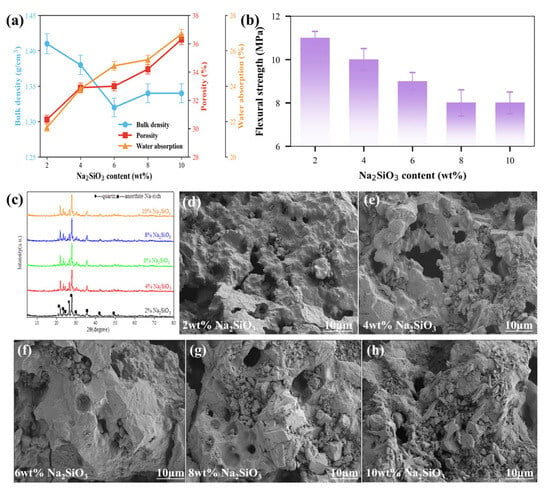
Figure 6.
(a) Bulk density, porosity, and water absorption of ceramic samples with different Na2SiO3 contents; (b) flexural strength of the materials as a function of Na2SiO3 content; (c) XRD patterns of samples with varying Na2SiO3 content and SEM images of fracture surfaces corresponding to Na2SiO3 contents of (d) 2 wt%, (e) 4 wt%, (f) 6 wt%, (g) 8 wt%, and (h) 10 wt%.
The SEM analysis (Figure 6d–h) offers direct morphological evidence for the structural transitions induced by Na2SiO3. At 2–6 wt%, the surfaces remain smooth and homogeneous, lacking distinct crystalline features, which is indicative of a predominantly amorphous or glassy matrix. At 8 wt%, prismatic grains appear and become more prominent at 10 wt%, marking the nucleation and growth of feldspathic crystalline phases. This microstructural evolution aligns with a slight increase in bulk density and the enhanced XRD intensity of Na–Ca-rich plagioclase peaks (Figure 6c), confirming the development of long-range crystalline order.
These crystallization behaviors correspond to the solid-state and ion exchange reactions discussed earlier, wherein Na2SiO3 facilitates the transformation of CaAl2Si2O8 into NaCaAl3Si5O16 (Reaction 5). This phase transition alters not only the mineralogical composition but also the packing efficiency of particles within the matrix. At 900 °C, the calculated ΔrGmθ is −89 kJ/mol, indicating that the reaction is thermodynamically favorable and proceeds spontaneously toward the formation of the product phase. Moderate additions of Na2SiO3 (≤6 wt%) promote densification through viscous flow sintering, as evidenced by increased bulk density and reduced porosity. In contrast, excessive additions (≥8 wt%) lead to phase separation and microstructural coarsening due to the crystallization of Na–Ca feldspar phases. These crystalline phases disrupt the continuity of the amorphous matrix, potentially introducing local heterogeneity and ultimately compromising the mechanical integrity of the material.
3.3.3. ZrO2
Zirconia (ZrO2) incorporation produces significant microstructural modifications in alumina-based composites. With a superior phase stability and ultralow thermal conductivity (2.1 W/m·K), zirconia enables the effective modulation of thermal expansion through stress-induced tetragonal-to-monoclinic phase transformation [57].
Bulk density exhibits a non-monotonic trend with increasing ZrO2 content: 1.50 g/cm3 at 2 wt%, slightly decreasing to 1.48 g/cm3 at 4 wt%, and rising to 1.52 g/cm3 at 10 wt% (Figure 7a). In contrast, porosity and water absorption reach minimum values (28.45% and 18.94%, respectively) at 8 wt%, indicating two competing mechanisms. At low concentrations (<6 wt%), the lattice mismatch between ZrO2 and Al2O3 generates microstructural porosity; at higher levels (≥8 wt%), partial liquid phase sintering contributes to densification [58,59]. Flexural strength reflects a similar behavior, increasing from 10 MPa at 4 wt% to 12.5 MPa at 10 wt% (Figure 7b). This enhancement is attributed to reduced porosity and a more uniform microstructure, underscoring the dominant role of pore-related failure.
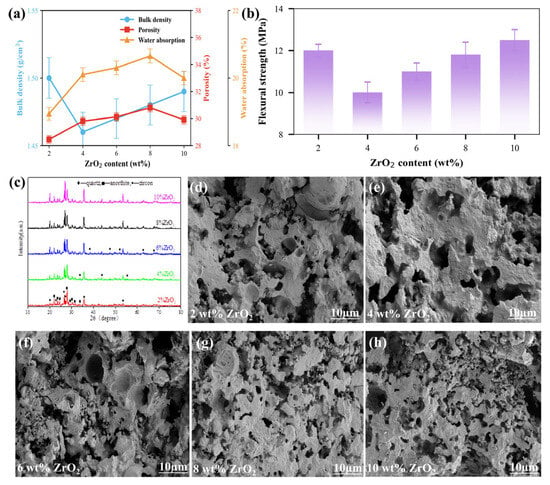
Figure 7.
(a) Bulk density, porosity, and water absorption of ceramic samples with different ZrO2 contents; (b) flexural strength of the materials as a function of ZrO2 content; (c) XRD patterns of samples with varying ZrO2 content and SEM images of fracture surfaces corresponding to ZrO2 contents of (d) 2 wt%, (e) 4 wt%, (f) 6 wt%, (g) 8 wt%, and (h) 10 wt%.
The XRD analysis (Figure 7c) identifies quartz (PDF# 46-1045), anorthite (PDF# 41-1486), and zircon (ZrSiO4, PDF# 06-0266) as the main crystalline phases. While quartz and anorthite remain largely unchanged, the zircon peaks intensify progressively with ZrO2 content, confirming in situ formation via the following mechanism (Equation (6)):
ZrO2 + SiO2 → ZrSiO4 (zircon) (ΔrGmθ = −184 kJ/mol, 1500 °C)
The SEM observations (Figure 7d–h) further support these findings. Although the overall morphologies remain similar, surface brightness increases with ZrO2 content, with localized whitening at 8–10 wt% likely reflecting fine zircon phase accumulation. Additionally, pore size decreases and micropores become more evenly distributed at higher ZrO2 levels, consistent with the observed densification and improved microstructural homogeneity.
3.3.4. TiO2
Titanium dioxide (TiO2), a thermally stable and chemically inert additive, plays a pivotal role in refining the microstructure and grain boundary characteristics of ceramic composites, thereby significantly enhancing their bulk physical properties [60,61]. Increasing TiO2 content from 2 to 10 wt% leads to a near-linear increase in bulk density (1.50 to 1.59 g/cm3, Figure 8a), accompanied by decreases in porosity (27.28% to 23.99%) and water absorption (18.12% to 15.10%). Correspondingly, flexural strength improves markedly by 58%, rising from 12 to 19 MPa (Figure 8b), confirming TiO2’s effectiveness in promoting densification and mechanical reinforcement.
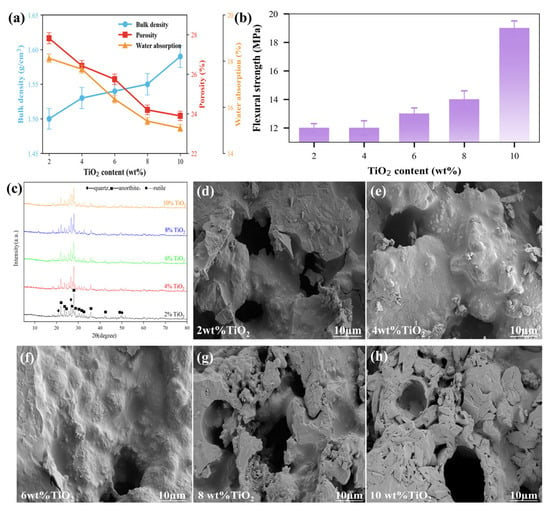
Figure 8.
(a) Bulk density, porosity, and water absorption of ceramic samples with different TiO2 contents; (b) flexural strength of the materials as a function of TiO2 content; (c) XRD patterns of samples with varying TiO2 content and SEM images of fracture surfaces corresponding to TiO2 contents of (d) 2 wt%, (e) 4 wt%, (f) 6 wt%, (g) 8 wt%, and (h) 10 wt%.
The X-ray diffraction (XRD) analysis (Figure 8c) identifies quartz (SiO2, PDF# 46-1045), anorthite (CaAl2Si2O8, PDF# 41-1486), and rutile TiO2 (PDF# 21-1276) as the dominant phases. The quartz peaks remain stable, indicating the preservation of the SiO4 tetrahedral network. In contrast, the gradual attenuation of the anorthite peaks with increasing TiO2 suggests the following solid-state interfacial reaction (Equation (7)):
CaAl2Si2O8 + TiO2 → CaTiAlSiO6 (titanium-aluminum diopside) + Al2O3
The absence of distinct CaTiAlSiO6 peaks implies that the reaction products may be incorporated into an amorphous grain boundary phase formed during sintering, which escapes XRD detection due to a lack of long-range order. This amorphous phase likely enhances particle bonding and pore filling, underpinning observed densification and strength improvements [62].
The SEM images (Figure 8d–h) corroborate these findings. At 2–6 wt% TiO2, surfaces are irregular without visible micropores or crystalline features and show minimal differences. At 8 wt%, discrete microcrystals with variable morphologies appear, evolving into prominent prismatic particles at 10 wt%, consistent with rutile TiO2 nucleation and growth. This microstructural evolution aligns with the XRD results, underscoring TiO2’s role in crystalline phase formation and microstructure refinement.
In conclusion, TiO2 functions dually as a phase regulator facilitating solid-state reactions and as a network modifier altering the amorphous grain boundary structure. This synergy optimizes the microstructure, enhancing the densification and mechanical properties without saturation up to 10 wt% TiO2.
A comprehensive evaluation identifies CaO as the optimal additive for electrolytic manganese residue–fly ash (EMR–FA) systems. Economically, CaO reduces the raw material costs by 40–60% compared with ZrO2, avoids the high-temperature catalytic inefficiency associated with TiO2, and eliminates the additional processing costs caused by the low water solubility of Na2SiO3. From a processing perspective, the strong alkalinity of CaO neutralizes SiO2-rich slag phases, lowers the melting temperature by 120–150 °C, and promotes liquid–phase sintering. In contrast, ZrO2 requires energy-intensive calcination, TiO2 needs co-doping to achieve functionality, and Na2SiO3 decomposes above 800 °C.
The CaO–SiO2–Al2O3 ternary system enhances high-temperature homogeneity by reducing melt viscosity through silicate network depolymerization and Ca2+ interstitial occupation, as supported by previous studies [59]. Comparatively, ZrO2 requires stabilizers to maintain crystal integrity, while TiO2 undergoes lattice distortion when Fe3+ substitutes for Ti4+ due to ionic size and charge differences [63]. Na2SiO3 tends to co-crystallize with impurity phases under typical sintering conditions. Calcium silicate phases such as CaSiO3, formed by the reaction between CaO and SiO2, are well known for their excellent mechanical properties. This significantly contributes to the improved compressive strength and durability of the composite [64,65]. Moreover, the CaO-based system avoids the redox instability often observed in TiO2-containing systems. Together, these findings conclusively establish CaO as the preferred additive for designing high-performance ceramic composites.
3.4. Heavy Metal Leaching Toxicity Analysis
After the high-temperature sintering of the composite EMR–FA–based ceramic, heavy–metal leaching was markedly reduced. The leaching concentrations of As fell from 2.74 mg L−1 in raw EMR to 0.59 mg L−1 in EMR–FA with 8 wt% CaO; and similarly for Cu from 0.41 to 0.14 mg L−1 and for Pb from 0.49 to 0.14 mg L−1 (Table 3). This result indicates that these elements were immobilized by chemical bonding and lattice solid solution. Under high-temperature conditions, CaO in the silicate melt reacted with MnO, Fe2O3, and other oxides to form stable calcium aluminosilicate and calcium ferrisilicate phases. As3+, Cu2+, and Pb2+ could then enter these lattices or be entrapped via ion adsorption and co-precipitation, reducing their mobility. In contrast, Cr immobilization was limited. Some samples showed a slight rise in Cr leaching. This suggests that Cr3+ did not form sufficiently stable coordination complexes or new phases. The limited fixation may stem from Cr’s redox potential and its weaker affinity for the matrix minerals.

Table 3.
Leaching concentrations of heavy metals from different ceramic formulations: EMR, FA, and EMR–FA composites with 8 wt% CaO, 2 wt% Na2SiO3, 10 wt% ZrO2, and 10 wt% TiO2 (mg/L).
For Cd, raw EMR released 34.40 µg L−1 (Table 3). After ceramic modification, Cd leaching dropped below 5 µg L−1. Notably, adding 10 wt% TiO2 produced nearly zero Cd release. This effect arises because of TiO2’s high surface area and the surface hydroxyl groups form strong coordination bonds with Cd2+ during sintering. Additionally, anionic vacancies in TiO2 lattice defects further adsorb and passivate Cd2+.
All additive-modified samples also showed Hg leaching below the national limit. This finding indicates that Hg was either co-precipitated with sulfide or sulfate phases or firmly encapsulated in the matrix under high-temperature conditions. By contrast, raw EMR released 189.29 mg L−1 of Mn, posing a significant ecological and physiological risk. The ceramic material reduced Mn leaching to below 38.4 mg L−1. This reduction is mainly due to the solid phase reaction between CaO and Mn2+ during sintering, which produces insoluble calcium manganese oxides. These oxides effectively passivate Mn2+ and inhibit its release.
3.5. Thermal Shock Resistance and Thermal Expansion Behavior
Thermal stability is a key property for evaluating the performance of ceramic materials under high-temperature and rapid thermal cycling conditions [64,65]. In this study, both the national standard GB/T 3810.9–2016 [66] and an enterprise standard were used to systematically test the thermal shock resistance and thermal expansion behavior of optimized ceramic samples. The selected samples represent the best-performing materials from each additive system, as summarized in Table 4.

Table 4.
Specific codes for different materials.
3.5.1. Thermal Shock Resistance
Thermal shock resistance (TSR) is a critical performance parameter for ceramics used in high-temperature applications, where rapid temperature fluctuations often lead to premature material failure and substantial economic losses [67]. Enhancing TSR is therefore essential for improving the service life and reliability of thermal equipment. In this study, TSR was systematically evaluated by subjecting ceramic samples to multiple heating–cooling cycles under both standard and enterprise-level test protocols.
As shown in Figure 9, most samples exhibited excellent thermal stability, with no visible macrocracks or surface damage observed after cycling, regardless of the testing criteria applied. These results indicate that the synthesized ceramic systems possess intrinsic resistance to thermal stress. However, a minor surface crack was detected in the sample containing 2 wt% Na2SiO3 under the more rigorous enterprise standard (Figure 10, red mark). This local failure is likely due to its relatively low bulk density, which can promote internal defect formation and thermal stress concentration. Under severe thermal gradients, such regions become preferential sites for crack initiation [68]. A specific note should be made that no visible cracks were observed in the remaining samples under the same magnification. The strong TSR observed in the majority of samples suggests a high potential for use in demanding thermal environments. Improved durability reduces component replacement frequency and maintenance downtime, offering considerable cost savings. This benefit is particularly relevant to continuous processing lines and critical high-temperature systems. Moreover, the enhanced thermal reliability aligns with current industry goals for energy efficiency and sustainable material use.
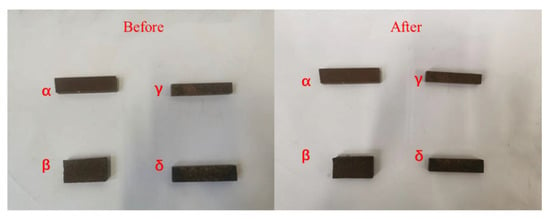
Figure 9.
Comparison of ceramic samples before and after thermal shock testing using the national standard evaluation method.
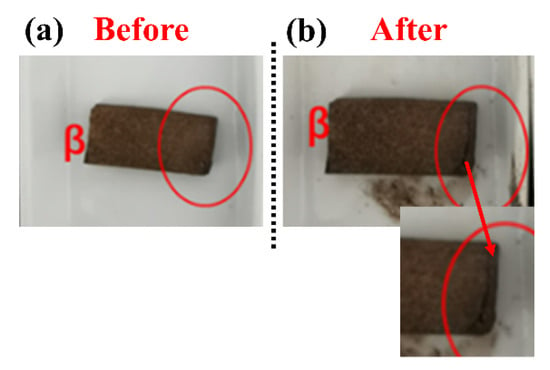
Figure 10.
Comparison of the β sample surfaces before and after thermal shock testing using the enterprise standard evaluation method.
To quantitatively assess the thermal shock stability of materials, we precisely measured the dimensional shrinkage of the specimens after thermal shock treatment (Table 5). The experimental results demonstrate that the α specimen exhibited the lowest shrinkage rate (2.45%), whereas the γ and β sample showed significantly higher shrinkage rates of 12.09% and 14.58%, respectively. These findings confirm the superior thermal shock resistance of the α sample.

Table 5.
Linear shrinkage of each sample before and after thermal shock testing.
3.5.2. Thermal Expansion Behavior
To better understand the thermal stress response of the developed ceramics, the coefficient of thermal expansion (CTE) was measured for the samples modified with various additives. As shown in Figure 11, different additives significantly influenced the thermal expansion behavior. In the range of room temperature to 300 °C, the CTE values of the CaO, ZrO2, and TiO2 modified samples were approximately 9.0 × 10−6/°C, 7.0 × 10−6/°C, and 6.0 × 10−6/°C, respectively. When the temperature increased from 300 °C to 700 °C, the CTE values of all samples decreased and stabilized between 5.6 × 10−6/°C and 7.0 × 10−6/°C. This low and steady thermal expansion is one of the key factors contributing to the improved thermal shock resistance in ceramic materials [69].
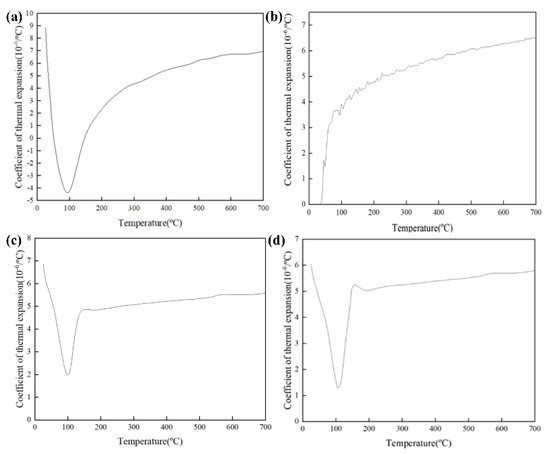
Figure 11.
Thermal expansion coefficients of the tested materials: (a) α, (b) β, (c) γ, and (d) δ.
In some cases, the samples exhibited a transition from positive to near-zero or even negative thermal expansion during heating. This anomalous behavior is often related to phase transitions or dynamic changes in the internal microstructure of the material [67].
The combination of controlled thermal expansion and the previously demonstrated thermal shock resistance confirms that the developed ceramics maintain structural stability under both thermal cycling and high-temperature conditions. These properties give the materials a competitive advantage in applications where conventional refractories often fail due to rapid or extreme temperature fluctuations.
3.6. Mechanisms of Reaction Processes
The primary phase in EMR gypsum (CaSO4·2H2O) undergoes thermal decomposition via a coupled thermodynamic–kinetic mechanism that governs both the phase transformation pathways and microstructural evolution in the EMR–FA-derived ceramic system. The decomposition of CaSO4·2H2O follows three distinct stages:
At this stage, approximately 1.5 molecules of water are removed from CaSO4·2H2O, resulting in the formation of bassanite (CaSO4·0.5H2O). This process involves the partial breaking and reorganization of [SO4]2−–Ca2+ bonds, along with the desorption of coordinated water [70,71,72].
With further heating, hemihydrate loses the remaining water and transforms into anhydrous CaSO4. Initially, the γ-CaSO4 phase may form, which can transition into more stable β-CaSO4 (anhydrite) at higher temperatures. This process typically completes in the 300–400 °C range, depending on the heating rate and environment [73,74].
At temperatures exceeding 850 °C, particularly above 1000 °C, anhydrous CaSO4 (especially the β-phase) begins to thermally decompose into CaO and SO3. This decomposition process generates SO3 gas, leading to the formation of gas bubbles in the molten phase, which in turn creates oriented porosity and promotes grain growth [75].
The CaO produced during decomposition acts as a key mineralizer. Through interfacial reaction kinetics, it controls the subsequent formation of the silicate network [76]. At temperatures above 900 °C, Ca2+ penetrates the SiO2 surface barrier and initiates Ca–Si–O nucleation by corner-sharing [SiO4] tetrahedra. When the temperature reaches 1100 °C, the Ca2+ concentration gradient drives Al3+ to substitute for Si4+ in the silica lattice, forming a CaAl2Si2O8 solid solution. Ultimately, the growth of a Ca-rich melt phase along grain boundaries enhances ionic migration, yielding a dense crystal–glass composite microstructure (Figure 12).
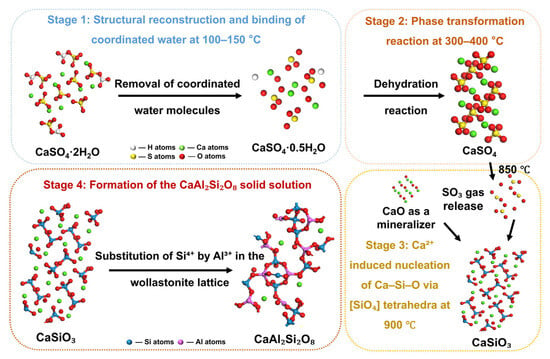
Figure 12.
Schematic illustration of the reaction mechanism for the EMR– FA-derived ceramic system.
4. Conclusions
This study proposes a sustainable strategy for synthesizing multifunctional ceramics through the high-temperature co-sintering of electrolytic manganese residue (EMR) and fly ash (FA). Physicochemical analyses revealed compositional complementarity between EMR and FA, with optimal synergy achieved at a composition of 45 wt% EMR, 40 wt% FA, and 15 wt% kaolin, and a sintering temperature of 1150 °C. SEM analysis confirmed significant microstructural densification under these conditions. Mechanistic investigations demonstrated distinct additive functionalities: CaO (8 wt%) enhanced densification by inducing CaSiO3 crystallization, while Na2SiO3 increased porosity through sodium-rich plagioclase formation. ZrO2 promoted zircon crystallization without altering bulk density, and TiO2 improved the mechanical properties via rutile phase growth. The ceramics exhibited exceptional heavy-metal immobilization capabilities, achieving fixation efficiencies of 78.6% (As), 68.9% (Pb), 73.8% (Cd), and 73.4% (Mn), complying with China’s hazardous waste identification standard GB 5085.3-2007. This work establishes a crystallization-guided paradigm for the high-value conversion of solid wastes, offering dual environmental and engineering advantages.
Author Contributions
Conceptualization, K.L. and X.S. (Xin Sun).; data curation, Z.H. and S.L.; formal analysis, K.L., G.A. and X.S. (Xin Shi); funding acquisition, K.L. and X.S. (Xin Sun); resources, Z.H. and G.A.; investigation, G.A. and X.S. (Xin Shi); methodology, Z.H., S.L. and G.A.; software, Z.L. and X.S. (Xin Shi); validation, Z.H., S.L. and Z.L.; writing—original draft, Z.H.; writing—review and editing, K.L., D.Z. and X.S. (Xin Sun). All authors have read and agreed to the published version of the manuscript.
Funding
This research was funded by the National Natural Science Foundation of China (Grant Nos. 52270106, 22266021, and 52204362), the Yunnan Major Scientific and Technological Projects (Grant No. 202505AT350002), and the Yunnan Key Laboratory of Phosphogypsum Recycling and Ecological Utilization (Grant No. 202449CE340028).
Institutional Review Board Statement
Not applicable.
Informed Consent Statement
Not applicable.
Data Availability Statement
Due to the ongoing use of the data in further research, the data supporting this study are not publicly available at this time to avoid compromising the research progress. Researchers who require access to the raw data may contact the corresponding author to request it. We will provide the data on a case-by-case basis, ensuring compliance with all relevant regulations.
Acknowledgments
This work was supported by the Faculty of Environmental Science and Engineering, Kunming University of Science and Technology.
Conflicts of Interest
The authors declare no conflicts of interest.
References
- Ashish, S.; Pankaj Kumar, D.; Abdul Wahab, H.; Mohammad, Y.; Hesam, K.; Shreeshivadasan, C. Challenges and opportunities of utilizing municipal solid waste as alternative building materials for sustainable development goals: A review. Sustain. Chem. Pharm. 2022, 27, 100706. [Google Scholar] [CrossRef]
- Kobayashi, T.; Nakajima, L. Sustainable development goals for advanced materials provided by industrial wastes and biomass sources. Curr. Opin. Green Sustain. Chem. 2021, 28, 100439. [Google Scholar] [CrossRef]
- Liu, Z.; Adams, M.; Cote, R.P.; Geng, Y.; Li, Y. Comparative study on the pathways of industrial parks towards sustainable development between China and Canada. Resour. Conserv. Recycl. 2018, 128, 417–425. [Google Scholar] [CrossRef]
- Su, L.; Wu, S.; Fu, G.; Zhu, W.; Zhang, X.; Liang, B. Creep characterisation and microstructural analysis of municipal solid waste incineration fly ash geopolymer backfill. Sci. Rep. 2024, 14, 29828. [Google Scholar] [CrossRef] [PubMed]
- Zhu, J.F.; Wang, Z.Q.; Tao, Y.L.; Ju, L.Y.; Yang, H. Macro–micro investigation on stabilization sludge as subgrade filler by the ternary blending of steel slag and fly ash and calcium carbide residue. J. Clean. Prod. 2024, 447, 141496. [Google Scholar] [CrossRef]
- Fu, Y.; Qiao, H.; Feng, Q.; Chen, K.; Li, Y.; Xue, C.; Zhang, Y. Review of new methods for resource utilisation of electrolytic manganese residue and its application in building materials. Constr. Build. Mater. 2023, 401, 132901. [Google Scholar] [CrossRef]
- He, S.; Jiang, D.; Hong, M.; Liu, Z. Hazard-free treatment and resource utilisation of electrolytic manganese residue: A review. J. Clean. Prod. 2021, 306, 127224. [Google Scholar] [CrossRef]
- He, D.; Shu, J.; Wang, R.; Chen, M.; Wang, R.; Gao, Y.; Liu, R.; Liu, Z.; Xu, Z.; Tan, D.; et al. A critical review on approaches for electrolytic manganese residue treatment and disposal technology: Reduction, pretreatment, and reuse. J. Hazard. Mater. 2021, 418, 126235. [Google Scholar] [CrossRef]
- Li, J.; Sun, P.; Li, J.; Lv, Y.; Ye, H.; Shao, L.; Du, D. Synthesis of electrolytic manganese residue-fly ash based geopolymers with high compressive strength. Constr. Build. Mater. 2020, 248, 118489. [Google Scholar] [CrossRef]
- Su, H.; Zhou, W.; Lyu, X.; Liu, X.; Gao, W.; Li, C.; Li, S. Remediation treatment and resource utilization trends of electrolytic manganese residue. Miner. Eng. 2023, 202, 108264. [Google Scholar] [CrossRef]
- Liu, T.; Zhao, G.; Qu, B.; Gong, C. Characterization of a fly ash-based hybrid well cement under different temperature curing conditions for natural gas hydrate drilling. Constr. Build. Mater. 2024, 445, 137874. [Google Scholar] [CrossRef]
- Jiang, Z.; He, G.; Duan, Y.; Jiang, Y.; Lin, Y.; Zhu, Y.; Wang, J. Contrasting effects of various factors upon the properties of foam ceramics and the mechanisms of crystalline phase reconstruction and microstructure regulation. Ceram. Int. 2024, 50, 21645–21657. [Google Scholar] [CrossRef]
- Bao, H.; Zheng, Z.; Xu, G.; Li, R.; Wang, Q.; Saafi, M.; Ye, J. Performance and mechanism of sand stabilization via microbial-induced CaCO3 precipitation using phosphogypsum. J. Clean. Prod. 2024, 468, 142999. [Google Scholar] [CrossRef]
- Venkatesan, G.; Alengaram, U.J.; Ibrahim, S.; Ibrahim, M.S.I. Effect of Fly Ash characteristics, sodium-based alkaline activators, and process variables on the compressive strength of siliceous Fly Ash geopolymers with microstructural properties: A comprehensive review. Constr. Build. Mater. 2024, 437, 136808. [Google Scholar] [CrossRef]
- Xu, W.; Tang, Z.; Xie, Y.; Long, G.; Zhu, H.; Kai, M.; Peng, L.; Wang, L.; Zaland, S. Effect of synthesis parameters on the alkali activation reaction degree and the relationship between reaction degree and microstructure of fly ash-based geopolymers. J. Build. Eng. 2024, 93, 109874. [Google Scholar] [CrossRef]
- Xiao, Y.; Cheng, D.; Li, G.; Yin, R.; Li, P.; Gao, Z. Preparation of MgO ceramics by low temperature sintering with MgF2 and Al2O3 as sintering additives. J. Electroceramics 2025, 54, 1–12. [Google Scholar] [CrossRef]
- Sun, J.; Zhang, Z.; Zhang, Y.; Zhang, X.; Guo, J.; Fu, Q.; Wu, L. High-temperature ablation resistance prediction of ceramic coatings using machine learning. J. Am. Ceram. Soc. 2024, 108, 20136. [Google Scholar] [CrossRef]
- Ma, W.; Zhu, G.; Guan, X.; Yan, K.; Li, H.; Meng, Z.; Zhang, W.; Li, Z. An innovative approach to prepare calcium oxide from calcium carbide slag based on sequential mineral transformation. ACS Sustain. Chem. Eng. 2024, 1, 1279–1290. [Google Scholar] [CrossRef]
- Tian, X.K.; Lin, S.C.; Yan, J.; Zhao, C.Y. Sintering mechanism of calcium oxide/calcium carbonate during thermochemical heat storage process. Chem. Eng. J. 2021, 428, 131229. [Google Scholar] [CrossRef]
- Ali, H.; Gepreel, M.A.-H. Limitations and advancements of Sodium Silicate inorganic sand binders; A review. Int. J. Mater. Technol. Innov. 2022, 2, 47–54. [Google Scholar] [CrossRef]
- He, F.; Wang, X.; Wu, D. Phase-change characteristics and thermal performance of form-stable n-alkanes/silica composite phase change materials fabricated by sodium silicate precursor. Renew. Energy 2015, 74, 689–698. [Google Scholar] [CrossRef]
- Hou, X.; Zhang, R.; Wang, B. Novel self-reinforcing ZrO2–SiO2 aerogels with high mechanical strength and ultralow thermal conductivity. Ceram. Int. 2018, 44, 15440–15445. [Google Scholar] [CrossRef]
- Srinivas, J.; Karthikeyan, K.R.; Senthil, T.; Yesuraj, K.; Aultrin, K.J. Characterization of Mechanical and Viscoelastic Properties of Ceramic Nanoparticle-Reinforced Polymer Composites. J. Polym. Compos. 2024, 13, 2321–2810. [Google Scholar]
- Chen, X.; Mao, S.S. Titanium dioxide nanomaterials: Synthesis, properties, modifications, and applications. Chem. Rev. 2007, 107, 2891–2959. [Google Scholar] [CrossRef] [PubMed]
- Liu, L.; Chen, X. Titanium dioxide nanomaterials: Self-structural modifications. Chem. Rev. 2014, 114, 9890–9918. [Google Scholar] [CrossRef] [PubMed]
- Sadia, S.I.; Shishir, M.K.H.; Ahmed, S.; Aidid, A.R.; Islam, M.M.; Rana, M.M.; Al-Reza, S.M.; Alam, M.A. Crystallographic biography on nanocrystalline phase of polymorphs titanium dioxide (TiO2): A perspective static review. S. Afr. J. Chem. Eng. 2024, 50, 51–64. [Google Scholar] [CrossRef]
- Ji, R.; Liu, Y.; Zhang, Y.; Wang, F. Machining performance of silicon carbide ceramic in end electric discharge milling. Int. J. Refract. Met. Hard Mater. 2010, 29, 117–122. [Google Scholar] [CrossRef]
- Ji, R.; Liu, Y.; Zhang, Y.; Cai, B.; Ma, J.; Li, X. Influence of dielectric and machining parameters on the process performance for electric discharge milling of SiC ceramic. Int. J. Adv. Manuf. Technol. 2011, 59, 127–136. [Google Scholar] [CrossRef]
- Ji, R.; Zhao, Q.; Zhao, L.; Liu, Y.; Jin, H.; Wang, L.; Wu, L.; Xu, Z. Study on high wear resistance surface texture of electrical discharge machining based on a new water-in-oil working fluid. Tribol. Int. 2023, 180, 108218. [Google Scholar] [CrossRef]
- Sha, F.; Dong, Y.; Gu, S.; Fan, X.; Xiao, W. Study on novel alkali-activated cementitious grout for scour control of offshore foundation. Geomech. Energy Environ. 2025, 42, 100663. [Google Scholar] [CrossRef]
- Liu, B.; Sun, J.; Guo, L.; Shi, H.; Feng, G.; Feldmann, L.; Yin, X.; Riedel, R.; Fu, Q.; Li, H. Materials design of silicon based ceramic coatings for high temperature oxidation protection. Mater. Sci. Eng. R Rep. 2025, 163, 100936. [Google Scholar] [CrossRef]
- Amorós, J.L.; Blasco, E.; Feliu, C.; Moreno, A. Effect of kaolin addition on the sinter-crystallisation kinetics of compacts of a crystallising frit. J. Non-Cryst. Solids 2022, 596, 121864. [Google Scholar] [CrossRef]
- HJ/T 299-2007; Identification Standards for Hazardous Wastes—Identification for Extraction Toxicity. Ministry of Environmental Protection of the People’s Republic of China: Beijing, China, 2007.
- JC/T 626–2006; Common Brick. Ministry of Housing and Urban-Rural Development of the People’s Republic of China: Beijing, China, 2006.
- Andrini, L.; Gauna, M.R.; Conconi, M.S.; Suarez, G.; Requejo, F.G.; Aglietti, E.F.; Rendtorff, N.M. Extended and local structural description of a kaolinitic clay, its fired ceramics and intermediates: An XRD and XANES analysis. Appl. Clay Sci. 2016, 124, 39–45. [Google Scholar] [CrossRef]
- Yang, H.L.; Li, Z.S.; Ding, Y.D.; Ge, Q.Q.; Shi, Y.J.; Jiang, L. Effect of Silicon Source (Fly Ash, Silica Dust, Gangue) on the Preparation of Porous Mullite Ceramics from Aluminum Dross. Materials 2022, 15, 7212. [Google Scholar] [CrossRef] [PubMed]
- Ding, C. Preparation and thermal shocks of mullite-based porous ceramic materials using the reaction sintering method. Int. J. Appl. Ceram. Technol. 2025, 22, e15091. [Google Scholar] [CrossRef]
- Li, J.; Liu, Y.; Ke, X.; Jiao, X.; Li, R.; Shi, C. Geopolymer synthesized from electrolytic manganese residue and lead-zinc smelting slag: Compressive strength and heavy metal immobilization. Cem. Concr. Compos. 2022, 134, 104806. [Google Scholar] [CrossRef]
- Jiang, J.; Luo, H.; Wang, S.; Ou, X.; Su, J.; Lyu, Z.; Chen, J.; Wei, D. Synthesis of tailing slurry-based geopolymers for the highly efficient immobilization of heavy metals: Behavior and mechanism. Appl. Clay Sci. 2023, 247, 107199. [Google Scholar] [CrossRef]
- Ushakov, S.V.; Navrotsky, A.; Green, D.J. Experimental Approaches to the Thermodynamics of Ceramics Above 1500 °C. J. Am. Ceram. Soc. 2012, 95, 1463–1482. [Google Scholar] [CrossRef]
- Heimann, R.B.; Maggetti, M. The struggle between thermodynamics and kinetics: Phase evolution of ancient and historical ceramics. GeoScienceWorld 2019, 20, 130. [Google Scholar]
- Wang, Z.; Lyu, X.; Yao, G.; Wu, P.; Wang, J.; Wei, J. Preparation of Ca–Si–Al–Mg porous ceramics by Co-operation of Ca&Mg-contained soda residue and altered rock gold tailings. J. Clean. Prod. 2020, 262, 121345. [Google Scholar]
- Megaw, H.D.; Kempster, C.J.E.; Radoslovich, E.W. The structure of anorthite, CaAl2Si2O8. II. Description and discussion. Acta Crystallogr. 1962, 15, 1017–1035. [Google Scholar] [CrossRef]
- Kushiro, I.; Yoder, H.S., Jr. Anorthite—Forsterite and Anorthite—Enstatite Reactions and their bearing on the Basalt—Eclogite Transformation. J. Petrol. 1966, 7, 337–362. [Google Scholar] [CrossRef]
- Cengizler, H.; Koç, M.; Şan, O. Production of ceramic glass foam of low thermal conductivity by a simple method entirely from fly ash. Ceram. Int. 2021, 47, 28460–28470. [Google Scholar] [CrossRef]
- Goga, F.; Dudric, R.; Cormos, C.; Imre, F.; Bizo, L.; Misca, R. Fly ash from thermal power plant, raw material for glass-ceramic. Environ. Eng. Manag. J. 2013, 12, 337–342. [Google Scholar] [CrossRef]
- Wons, W.; Rzepa, K.; Reben, M.; Murzyn, P.; Sitarz, M.; Olejniczak, Z. Effect of thermal processing on the structural characteristics of fly ashes. J. Mol. Struct. 2018, 1165, 299–304. [Google Scholar] [CrossRef]
- Wang, C.; Yan, W.; Chen, Q.; Wang, X. Microstructures and properties of microporous MgO-MgAl2O4 refractory aggregates from Mg(OH)2 powder and α-Al2O3 micro-powder. Constr. Build. Mater. 2024, 426, 136144. [Google Scholar] [CrossRef]
- Tu, Y.; Zhang, Y.; Su, Z.; Jiang, T. Mineralization mechanism of limonitic laterite sinter under different fuel dosage: Effect of FeO. Powder Technol. 2022, 398, 117064. [Google Scholar] [CrossRef]
- Chen, L.; Wang, C.; Wang, Z.; Anthony, E.J. The kinetics and pore structure of sorbents during the simultaneous calcination/sulfation of limestone in CFB. Fuel 2017, 208, 203–213. [Google Scholar] [CrossRef]
- Kucharczyk, S.; Sitarz, M.; Zajac, M.; Deja, J. The effect of CaO/SiO2 molar ratio of CaO-Al2O3-SiO2 glasses on their structure and reactivity in alkali activated system. Spectrochim. Acta Part A Mol. Biomol. Spectrosc. 2018, 194, 163–171. [Google Scholar] [CrossRef] [PubMed]
- Zheng, H.; Duan, Y.; Li, M.; Wang, P.; Pang, B.; Xu, H.; Hou, D. Unveiling the dissolution mechanism of calcium ions from CSH substrates in Na2SO4 solution: Effects of Ca/Si ratio. Appl. Surf. Sci. 2025, 680, 161443. [Google Scholar] [CrossRef]
- Maruyama, I.; Kontani, O.; Takizawa, M.; Sawada, S.; Ishikawao, S.; Yasukouchi, J.; Sato, O.; Etoh, J.; Igari, T. Development of soundness assessment procedure for concrete members affected by neutron and gamma-ray irradiation. J. Adv. Concr. Technol. 2017, 15, 440–523. [Google Scholar] [CrossRef]
- Chakraborty, S.; Sheikh, M.A. Synthesis of sodium silicate and its application of dielectric relaxation spectroscopy—A report. J. Micromechanics Mol. Phys. 2024, 9, 15–19. [Google Scholar] [CrossRef]
- Manurung, R.; Hasibuan, R.; Siregar, A.G.A. Preparation and characterization of lithium, sodium, and potassium silicate from palm leaf as a potential solid base catalyst in developed biodiesel production. Case Stud. Chem. Environ. Eng. 2024, 9, 100543. [Google Scholar] [CrossRef]
- Sheikh, M.A.; Chakraborty, S. Spectroscopic approach to understanding complex impedance in sodium silicate. Phys. Open 2025, 23, 100255. [Google Scholar] [CrossRef]
- Sengupta, P.; Bhattacharjee, A.; Maiti, H.S. Zirconia: A Unique Multifunctional Ceramic Material. Trans. Indian Inst. Met. 2019, 72, 1981–1998. [Google Scholar] [CrossRef]
- Zheng, W.; Cui, J.; Sheng, L.; Chao, H.; Peng, Z.; Shen, C. Effect of complex nucleation agents on preparation and crystallization of CaO-MgO-Al2O3-SiO2 glass-ceramics for float process. J. Non-Cryst. Solids 2016, 450, 6–11. [Google Scholar] [CrossRef]
- Celtek, M.; Sengul, S. Thermodynamic and dynamical properties and structural evolution of binary Zr80Pt20 metallic liquids and glasses: Molecular dynamics simulations. J. Non-Cryst. Solids 2018, 498, 32–41. [Google Scholar] [CrossRef]
- Sathiyakumar, M.; Gnanam, F.D. Influence of MnO and TiO2 additives on density, microstructure and mechanical properties of Al2O3. Ceram. Int. 2002, 28, 195–200. [Google Scholar] [CrossRef]
- Sun, M.; Zheng, X.; Liu, X.; Wang, J.; Han, B.; Wu, S.; Zhao, R.; Zhu, Z.; Shen, S.; Liu, S. Effects of TiO2 nanobelts addition on microstructure and physical properties of vitrified bonds. Ceram. Int. 2024, 50, 45125–45132. [Google Scholar] [CrossRef]
- Maeda, K.; Sera, Y.; Yasumori, A. Effect of molybdenum and titanium oxides on mechanical and thermal properties of cordierite–enstatite glass-ceramics. J. Non-Cryst. Solids 2016, 434, 13–22. [Google Scholar] [CrossRef]
- Li, Q.; Jiang, G.; Dong, J.; Hou, J.; He, G. Damping behavior and energy absorption capability of porous magnesium. J. Alloys Compd. 2016, 680, 522–530. [Google Scholar] [CrossRef]
- Liu, L.; Liu, Y.; Tian, X.; Chen, X. Superior CO2 uptake and enhanced compressive strength for carbonation curing of cement-based materials via flue gas. Constr. Build. Mater. 2022, 346, 128364. [Google Scholar] [CrossRef]
- Shao, F.; Zhao, H.; Ni, J.; Zhuang, Y.; Sheng, J.; Yang, J.; Zhong, X.; Tao, S. Corrosion behavior and mechanical properties of plasma sprayed Al2O3-aluminum bronze and Ca2SiO4-aluminum bronze coatings. Mater. Chem. Phys. 2023, 311, 128579. [Google Scholar] [CrossRef]
- 66. GB/T 3810.9–2016; Test Methods for Ceramic Tiles—Part 9: Resistance to Thermal Shock. Standardization Administration of China: Beijing, China, 2016.
- Belmonte, M. Advanced ceramic materials for high temperature applications. Adv. Eng. Mater. 2006, 8, 693–703. [Google Scholar] [CrossRef]
- Justin, J.; Jankowiak, A. Ultra High Temperature Ceramics: Densification, Properties and Thermal Stability. Aerosp. Lab. 2011, 3, 1–11. [Google Scholar]
- Li, K.; Wang, D.; Chen, H.; Guo, L. Normalized evaluation of thermal shock resistance for ceramic materials. J. Adv. Ceram. 2014, 3, 250–258. [Google Scholar] [CrossRef]
- Dove, M.T.; Fang, H. Negative thermal expansion and associated anomalous physical properties: Review of the lattice dynamics theoretical foundation. Rep. Prog. Phys. 2016, 79, 066503. [Google Scholar] [CrossRef]
- Şener, S.; Bilgen, S.; Özbayoğlu, G. Effect of heat treatment on grindabilities of celestite and gypsum and separation of heated mixture by differential grinding. Miner. Eng. 2004, 17, 473–475. [Google Scholar] [CrossRef]
- Singh, N.B.; Middendorf, B. Calcium sulphate hemihydrate hydration leading to gypsum crystallization. Prog. Cryst. Growth Charact. Mater. 2007, 53, 57–77. [Google Scholar] [CrossRef]
- Gurgul, S.J.; Seng, G.; Williams, G.R. A kinetic and mechanistic study into the transformation of calcium sulfate hemihydrate to dihydrate. J. Synchrotron Radiat. 2019, 26, 774–784. [Google Scholar] [CrossRef]
- Pankrushina, E.A.; Votyakov, S.L.; Shchapova, Y.V. Statistical approaches in the analysis of in situ thermo-Raman spectroscopic data for gypsum as a basis for studying dehydration and phase transformations in crystalline hydrates. J. Raman Spectrosc. 2021, 52, 877–889. [Google Scholar] [CrossRef]
- Tian, H.; Guo, Q.; Chang, J. Investigation into Decomposition Behavior of CaSO4 in Chemical-Looping Combustion. Energy Fuels 2008, 22, 3915–3921. [Google Scholar] [CrossRef]
- Sheng, S.U.; Tao, L.I.U.; Yi, W.A.N.G.; Song, H.U. Study on CO2 absorption-mineralization characteristics of mixed amine solution coupled with CaO and key influencing factors in mineralization process. J. Fuel Chem. Technol. 2022, 50, 1371–1380. [Google Scholar]
Disclaimer/Publisher’s Note: The statements, opinions and data contained in all publications are solely those of the individual author(s) and contributor(s) and not of MDPI and/or the editor(s). MDPI and/or the editor(s) disclaim responsibility for any injury to people or property resulting from any ideas, methods, instructions or products referred to in the content. |
© 2025 by the authors. Licensee MDPI, Basel, Switzerland. This article is an open access article distributed under the terms and conditions of the Creative Commons Attribution (CC BY) license (https://creativecommons.org/licenses/by/4.0/).